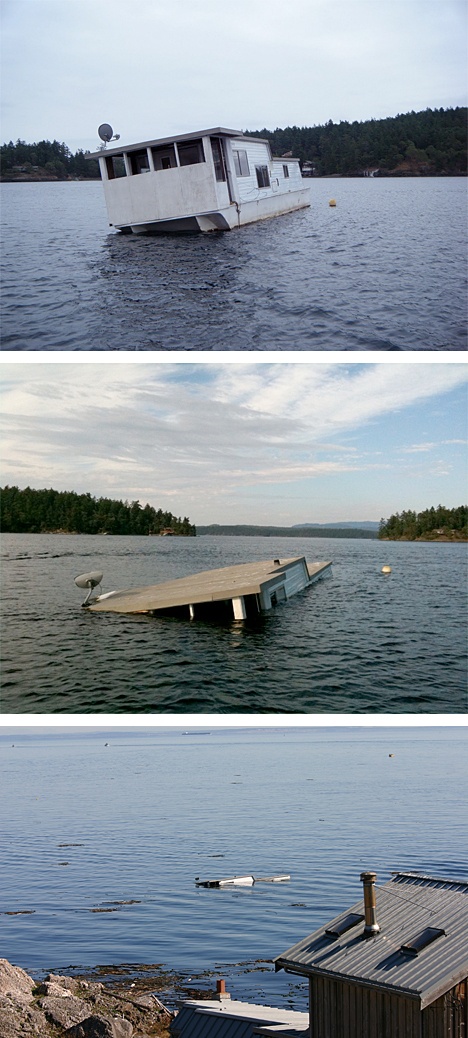Like a swimmer with Michael Phelps-like strength, a 35- to 40-foot pontoon houseboat that partially sank off Jensen’s Shipyard has made its way to Eagle Cove off the west side of San Juan Island.
The houseboat, which was photographed off Jensen’s taking on water Aug. 2 and partially submerged Sept. 2, was sighted off Eagle Cove today. The houseboat is believed to have been buoyed by the currents around Turn Island, through Cattle Pass and to its current spot near Eagle Point.
Officials with the state Department of Natural Resources Derelict Vessel Program were meeting today to determine a course of action. For some, that action couldn’t come soon enough.
David Halpern, an Eagle Cove resident, expressed concern about the potential for contamination in an area known to be frequented by killer whales. He’s worried that the boat will be broken up by currents and rocks.
The problem is, no one wants to claim responsibility for the houseboat yet. Sources say the owner has said she sold the boat, but Les Soland of Vessel Assist said she never transferred the title.
“The person on the title is responsible. Cut and dried, that’s it,” he said. “The issue is somebody spending the money to enforce it, to say, ‘Here’s the law, you’re responsible.'”
On that, agencies are in wait-and-see mode. If the vessel becomes a hazard to navigation, it becomes the responsibility of — and the expense of — the U.S. Coast Guard.
“If someone strikes it and it’s a hazard to navigation, I’m sure there are civil remedies,” Sheriff Bill Cumming said.
If the houseboat becomes an environmental hazard, then it becomes the responsibility of the state Department of Natural Resources.
If it washes ashore on National Park property, the National Park could pursue reimbursement from the houseboat’s owner for its removal. Ditto for DNR if it removes the houseboat as a derelict vessel; the state’s Derelict Vessel Program allows DNR to remove derelict vessels and seek reimbursement from the vessel’s last registered owner.
BULLETIN: Jackie Wolf of Islands Oil Spill Association said DNR is sending someone to the scene today to evaluate, and may make arrangements “to remove it and deal with it” Wednesday.
If DNR removes the houseboat, it must store it somewhere and try to get in touch with the vessel’s legal owners.
Soland said the vessel, which was unoccupied when it was anchored in the bay off of Jensen’s Shipyard, apparently broke loose from its mooring in late July/early August and went aground on Barbara Buck’s beach, adjacent to the former Kwan Lama resort. He said no one would admit owning the houseboat. “They all said, ‘Don’t come to me,'” he said. Then the houseboat went back into the bay, got hung up on a mooring and stayed.
Aug. 2, Vessel Assist photographed the houseboat taking on water in one of its pontoons. “When it had taken on about a foot and a half of water, we called DNR, but they said that if there are no hazardous materials onboard, it is still hers,” Soland said.
Within a month, the houseboat was partially submerged.
“When the boat started going down, it finally came unhooked and everyone said, ‘Heavens, now we have a problem.’ Yeah, but nobody wanted to take responsibility.”
Soland said a “little bit of an oil sheen” was visible after the houseboat sank, but the sheen went away after a day or two.
“There was a rumor that it had 50 gallons of diesel on board, but we don’t know that,” he said.



